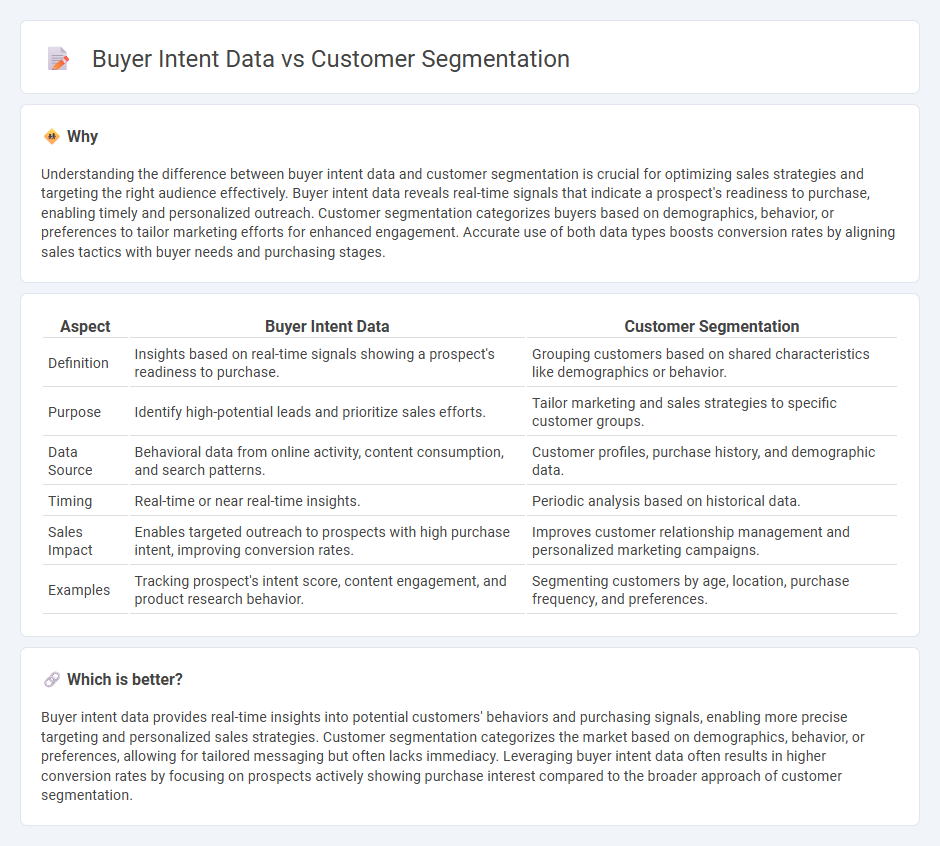
Buyer intent data provides insights into potential customers' online behavior, revealing their readiness to purchase, while customer segmentation categorizes existing customers based on demographics and purchasing patterns. Combining buyer intent data with customer segmentation enables sales teams to target prospects more effectively and personalize outreach strategies for higher conversion rates. Explore how integrating these approaches can boost your sales performance.
Why it is important
Understanding the difference between buyer intent data and customer segmentation is crucial for optimizing sales strategies and targeting the right audience effectively. Buyer intent data reveals real-time signals that indicate a prospect's readiness to purchase, enabling timely and personalized outreach. Customer segmentation categorizes buyers based on demographics, behavior, or preferences to tailor marketing efforts for enhanced engagement. Accurate use of both data types boosts conversion rates by aligning sales tactics with buyer needs and purchasing stages.
Comparison Table
| Aspect | Buyer Intent Data | Customer Segmentation |
|---|---|---|
| Definition | Insights based on real-time signals showing a prospect's readiness to purchase. | Grouping customers based on shared characteristics like demographics or behavior. |
| Purpose | Identify high-potential leads and prioritize sales efforts. | Tailor marketing and sales strategies to specific customer groups. |
| Data Source | Behavioral data from online activity, content consumption, and search patterns. | Customer profiles, purchase history, and demographic data. |
| Timing | Real-time or near real-time insights. | Periodic analysis based on historical data. |
| Sales Impact | Enables targeted outreach to prospects with high purchase intent, improving conversion rates. | Improves customer relationship management and personalized marketing campaigns. |
| Examples | Tracking prospect's intent score, content engagement, and product research behavior. | Segmenting customers by age, location, purchase frequency, and preferences. |
Which is better?
Buyer intent data provides real-time insights into potential customers' behaviors and purchasing signals, enabling more precise targeting and personalized sales strategies. Customer segmentation categorizes the market based on demographics, behavior, or preferences, allowing for tailored messaging but often lacks immediacy. Leveraging buyer intent data often results in higher conversion rates by focusing on prospects actively showing purchase interest compared to the broader approach of customer segmentation.
Connection
Buyer intent data reveals potential customers' interests and readiness to purchase by analyzing online behaviors, which enhances the precision of customer segmentation. Effective customer segmentation groups these buyers based on intent signals, demographics, and purchasing patterns, allowing sales teams to tailor marketing campaigns and prioritize high-value prospects. Leveraging both buyer intent data and segmentation drives higher conversion rates and optimized sales strategies.
Key Terms
**Customer Segmentation:**
Customer segmentation categorizes customers based on demographics, behavior, and purchasing patterns to tailor marketing strategies and enhance customer experiences. It enables businesses to identify high-value segments and optimize resource allocation for targeted campaigns. Explore how leveraging customer segmentation can boost your market effectiveness and ROI.
Demographics
Customer segmentation categorizes audiences based on demographics such as age, gender, income, and location, enabling tailored marketing strategies. Buyer intent data, however, identifies potential customers' behaviors and signals indicating their readiness to purchase, offering deeper insight beyond demographic traits. Explore how combining both approaches enhances targeted marketing effectiveness and drives higher conversion rates.
Psychographics
Customer segmentation categorizes consumers based on demographics, behaviors, and psychographics such as values, interests, and lifestyles to tailor marketing strategies effectively. Buyer intent data captures real-time behavioral signals indicating a prospect's readiness to purchase, enhancing targeting precision but with less emphasis on deep psychological traits. Explore how integrating psychographic insights with buyer intent data can optimize personalized marketing campaigns and improve conversion rates.
Source and External Links
What Is Customer Segmentation? | Definition from TechTarget - Customer segmentation is the practice of dividing a customer base into groups with similar characteristics relevant to marketing, such as age, gender, interests, and spending habits, to enable more personalized and effective marketing efforts.
What is Customer Segmentation? - Customer segmentation organizes customers into specific groups based on shared characteristics, behaviors, or preferences, allowing businesses to deliver the right message to the right user at the right time for improved customer experience and campaign effectiveness.
Customer Segmentation Meaning & Analysis Models | Optimove - Customer segmentation involves dividing customers into groups that reflect similarities in behaviors, preferences, or lifetime value, often using data analytics and machine learning to enable precise, data-driven marketing strategies.
 dowidth.com
dowidth.com